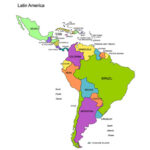Key Points:
-
The average annual temperature of the contiguous U.S. was 53.4°F, which is 1.4°F above average, ranking in the warmest third of the record.
-
Annual precipitation for the contiguous U.S. was 28.35 inches, 1.59 inches below average, ranking in the driest third of the historical record.
-
There were 18 separate billion-dollar weather and climate disaster events identified during 2022 — the third-highest disaster count and the third-costliest year in the 43-year record.
-
Hurricane Ian devastated parts of Florida in September and was the third-costliest U.S. hurricane on record, behind Hurricane Katrina (2005) and Hurricane Harvey (2017).
-
The North Atlantic Basin saw 14 named storms form during 2022, which is near the historical average. The accumulated cyclone energy* (ACE) for the basin was about 80% of the annual average.
-
The preliminary tornado count for 2022 was near average with 1,331 tornadoes reported.
-
The Hermits Peak Fire became the largest wildfire on record in New Mexico at more than 341,000 acres consumed between April and June. Over 66,000 fires burned around 7.5 million acres across the U.S. this year, which is near average.
-
Drought coverage across the contiguous U.S. remained significant for the second year in a row with a minimum extent of 44% occurring on September 6 and a maximum coverage of 63% on October 25 — the largest contiguous U.S. footprint since the drought of 2012.
-
Drought impacted much of the western half of the U.S. for a majority of the year with many major reservoirs at or near record-low levels.
-
40% or more of the contiguous U.S. has been in drought for the last 119 weeks. This is a record in the 22-year U.S. Drought Monitor history. The previous record was 68 consecutive weeks (June 2012 – October 2013).
Other Highlights:
Temperature

For the year, temperatures were above average from the West Coast to the Gulf of Mexico and from Florida to New England and into the Great Lakes. Florida and Rhode Island ranked fifth warmest while Massachusetts ranked sixth warmest in the 128-year record. Four additional states experienced a top-10 warmest January-December on record. A heatwave across the southern Plains began in April and lasted well into the summer, giving Texas their warmest (and fourth driest) April to July on record.
The Alaska January-December temperature was 28.6°F, 2.6°F above the long-term average, ranking 16th warmest in the 98-year record for the state. Above-average temperatures were observed across the vast majority of the state for this annual period with portions of the eastern Interior and Panhandle near average.
Precipitation

Precipitation was above average across the lower Mississippi Valley to New England, portions of the northern Plains, Great Lakes, and parts of the Pacific Northwest, Southwest and Rockies. Precipitation was below average across much of the West, central and southern Plains, and parts of the Great Lakes and Southeast. Nebraska ranked fourth driest while California ranked ninth driest on record.
The annual precipitation ranked fourth wettest on record for Alaska, with above average to record-high precipitation observed across all but the Central Interior and South Panhandle regions with below-average precipitation observed in the Aleutians. Juneau had its wettest year on record and Anchorage its wettest year in more than seven decades during 2022.
Drought

Drought expanded across the West in early 2022 and reached a peak coverage of 91.3% of the region on May 3. Drought coverage across the West shrank as the summer monsoon reduced some of the coverage in the Southwest. The multi-year western U.S. drought resulted in water stress/shortages across many locations in 2022 as some major reservoirs dropped to their lowest levels on record.
Extreme short-term dryness across the Ohio and Tennessee valleys during late summer/early fall, combined with persistent dryness across the Missouri and Arkansas-White-Red River basins, resulted in reduced streamflow in the Mississippi River to the lowest water levels in a decade, closing off a vital channel to barge traffic at a crucial time of the year for transport of crops from the nation’s heartland.
Tropical Cyclones
During 2022, 14 named storms formed in the North Atlantic Basin (four tropical storms, eight hurricanes and two major hurricanes), which is near the historical average.
August had no tropical storm activity in the North Atlantic Basin, with 2022 becoming only the third year, along with 1961 and 1997, since 1950 to have no activity during the month.
Several notable storms brought destruction and flooding to portions of the U.S. and its territories during the months of September and November:
-
The powerful remnants of Typhoon Merbok pounded Alaska’s western coast on September 17, pushing homes off their foundations and tearing apart protective berms as water flooded communities. This was the strongest storm to enter the Bering Sea during September in 70 years.
-
On September 18, Hurricane Fiona brought massive flooding to Puerto Rico, with some areas receiving 12-18 inches of rain. One station reported more than two feet of rain in a 24-hour period.
-
Hurricane Ian, with 150 mph sustained winds, made landfall in southwest Florida as a strong Category 4 hurricane on September 28, resulting in major flooding, damage and loss of life.
-
On November 10, Hurricane Nicole made landfall along Florida’s eastern shore, flooding the coast and knocking out power to hundreds of thousands of people. Nicole was the first hurricane to hit the U.S. during November in nearly 40 years.
Wildfires
In addition to the active wildfire year across the western U.S., Alaska saw one million acres burned by June 18 — the earliest such occurrence in a calendar year than anytime in the last 32 years. By July 1, 1.85 million acres had been consumed — the second-highest June total on record and the seventh-highest acreage burned for any calendar month on record for Alaska.
Snowfall
Snowfall during the 2021-2022 snow season began in earnest with several atmospheric river events that brought early accumulations to parts of the Sierra, Cascades and central Rockies in October and December 2021. The snow season across the West waned during the second half of winter and ended with below-average snowpack across much of the region. From the central Plains to the Great Lakes and into the Northeast, snowfall was below average in December 2021. By January 2022, snow cover was above average across portions of the northern Plains, Midwest, Great Lakes and from the Appalachians to the Northeast. February remained well below average from the northeastern Rockies to the central Plains and across the central Appalachians.
The 2022-2023 snow season was off to a good start during December 2022 after a powerful arctic front brought heavy snow across much of the country. More than 55% of the contiguous U.S. was covered by snow across much of the Pacific Northwest and mountainous West to the Tennessee Valley and from the Tennessee Valley to New England on Christmas Eve. During the last week of December and first week of January 2023, a series of strong atmospheric rivers ushered in copious amounts of rain to much of California and snow to the Sierra Nevada Range, helping to reduce drought and build up the winter snowpack.
Tornadoes
The 2022 preliminary tornado count was about 9% above the 1991-2020 annual average across the contiguous U.S. with 1,331 tornadoes reported. March had triple the average number of tornadoes reported (293) and the most tornadoes reported for any March in the 1950-2022 record.
-
Supercell thunderstorms traversed Iowa and produced multiple tornadoes on March 5. The first EF4 tornado in Iowa since October 2013 was confirmed and had the second-longest tornado path in Iowa since 1980. Six fatalities were reported with this tornado.
-
On November 4-5, a tornado outbreak occurred across portions of Texas, Oklahoma, Louisiana and Arkansas. A total of 31 tornadoes was confirmed by the National Weather Service, including two EF4 tornadoes, which brought significant damage to the region including mass power outages.
-
On November 29-30, severe storms and tornadoes swept through parts of the South, downing trees, damaging homes in parts of Alabama and Mississippi. The National Weather Service confirmed 11 tornadoes during this outbreak including two EF3 tornadoes.
Climate Extremes Index
The U.S. Climate Extremes Index (USCEI) for 2022 was near average and ranked in the middle third of the 113-year record. Elevated warm extremes in both maximum and minimum temperature were observed across portions of the Northeast, Southeast, South, Southwest and West. Elevated extremes in dry Palmer Drought Severity Index values were also seen across much of the western U.S. The USCEI is an index that tracks extremes (falling in the upper or lower 10% of the record) in temperature, precipitation, drought and landfalling tropical cyclones across the contiguous U.S.
Billion-Dollar Weather and Climate Disasters
In 2022, the U.S. experienced 18 weather and climate disasters each incurring losses that exceeded $1 billion. These disasters included: six severe storms, three tropical cyclones, three hail events, two tornadoes and one each for drought, flood, winter storm and wildfire events.
The U.S. disaster costs for 2022 exceeded $165 billion, which is the third-highest cost on record.
-
Hurricane Ian is the third most costly U.S. hurricane on record ($112.9 billion), behind only Hurricane Katrina (2005) and Hurricane Harvey (2017).
-
The 2022 Western/Central Drought and Heat Wave was one of the more costly droughts on record, with a diverse array of direct impacts across different regions and industries. The drought’s $22.2 billion cost was the second most expensive event for 2022.
Over the last seven years (2016-2022), 122 separate billion-dollar disasters have killed at least 5,000 people and cost greater than $1 trillion in damage.
This is also a record eighth-consecutive year where the U.S. experienced 10 or more billion-dollar disasters.
Since records began in 1980, the U.S. has sustained 341 separate weather and climate disasters where overall damages/costs reached or exceeded $1 billion (based on the CPI adjustment to 2022) per event. The total cost of these 341 events exceeds $2.475 trillion.
* Accumulated Cyclone Energy (ACE) is an integrated metric of the strength, frequency and duration of tropical systems.
This annual summary from NOAA National Centers for Environmental Information is part of the suite of climate services NOAA provides to government, business, academia and the public to support informed decision-making. For more detailed climate information, check out our comprehensive Annual 2022 U.S. Climate Report scheduled for release on January 12, 2023.





